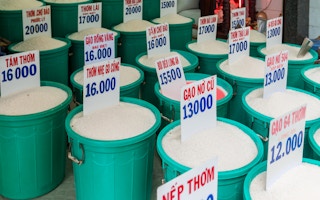We are in the middle of one of the biggest experiments in human history. At its core is the homogenisation of global food systems, which increasingly must deliver the same products to an expanding population (in all senses) across the world.
I now live in Kajang, in the Klang Valley around Kuala Lumpur, Malaysia. This area typifies many fast emerging economies where increasing wealth and aspirations lead to an appetite for global brands – to buy and to eat. Within a few kilometres of my house I can purchase the same fast-food as in New York, London or Sydney.
The first McDonald’s in Kuala Lumpur opened in 1982. Now, there are more than 250 restaurants in Malaysia, with 42 per cent of the local fast-food market in the Klang Valley. It is hard to imagine that when the McDonald brothers opened their first branch in California in 1940, they would initiate a global phenomenon whereby 70 million customers in 118 countries would consume an estimated 1 per cent of the food eaten every day on the planet in a McDonald’s outlet.
Kajang actually claims to be the home of satay. However, it seems inconceivable that a local “mamak” stall owner could ever sell satay on virtually every street corner around the world. McDonald’s now serves 144 million “happy meals” in Malaysian outlets each year. Presumably, this saves 144 million bored Malaysians from staring into their bowls of curry mee, satay and Roti Canai.
Global systems for global food
The homogenisation of global food systems means that any fast-food outlet must depend on a long, complex and increasingly vulnerable supply chain to source products whose ingredients are derived from a tiny range of plant and animal species. While there are an estimated 30,000 edible plant species, just three (wheat, rice and maize) now account for more than 60 per cent of the calories consumed by 7 billion people across the world.
If we disturb the supply chains or the productivity of these major crops we are in trouble – wherever we live. Precisely because of their global significance and the consequences of their failure, virtually all our agricultural research, funding and promotion focuses exclusively on squeezing more out of these major crops grown as monocultures.
“
Our entire food system is in a precarious state, propped up by a narrow elite range of major crops backed by global research and advocacy. Meanwhile everything else, including the underutilised and ignored crops that could sustain us in the future, is increasingly starved of resources.
As the climate changes, our increasing reliance on a few major crops will jeopardise food security. The recent IPCC (2014) report predicts that, without adaptation, temperature increases of above about 1o C from pre-industrial levels will negatively affect yields on the major crops in both tropical and temperate regions for the rest of the century.
These impacts need to be seen in the context of crop demand, which is predicted to increase by about 14 per cent per decade until 2050. In a recent study in Nature, an international team of scientists found that iron and zinc concentrations were substantially reduced in wheat, rice, soybean and pea crops grown under the CO2 levels expected by 2050. In other words, climate change will reduce both the yield and the nutritional content of the world’s major crops – leaving many hungry and malnourished.
While we might modify the characteristics and management of major crops sufficiently to yield under the lower range of temperature increases, we are unlikely to succeed at higher temperatures. So what should we do for agriculture in hotter, drier climates? A good start would be to explore the many hundreds of underutilised crops that have survived, yielded and fed people for millennia despite, not because of, agricultural science.
For example, bambara groundnut (Vigna subterranea) is a highly nutritious, drought-tolerant African food legume. However, during Africa’s colonial period it was increasingly displaced by the oil-rich peanut, grown for its cash and export potential. Bambara – “the groundnut of the women” – has survived more through its own resilience and the tenacity of the communities that have cultivated it than the contribution of agricultural scientists to its improvement or extension agencies to its expansion.
Our entire food system is in a precarious state, propped up by a narrow elite range of major crops backed by global research and advocacy. Meanwhile everything else, including the underutilised and ignored crops that could sustain us in the future, is increasingly starved of resources.
Without urgent, serious and comparative research on crops that can yield in hotter, volatile climates of the future, the global food system will increasingly depend on only a few crops. Future generations will not thank us for allowing the rest to wither away.
Sayed Azam-Ali is the chief executive of Crops for the Future Research Centre and Professor of Global Food Security at the University of Nottingham. This post originally appeared on The Conversation.
![]()











